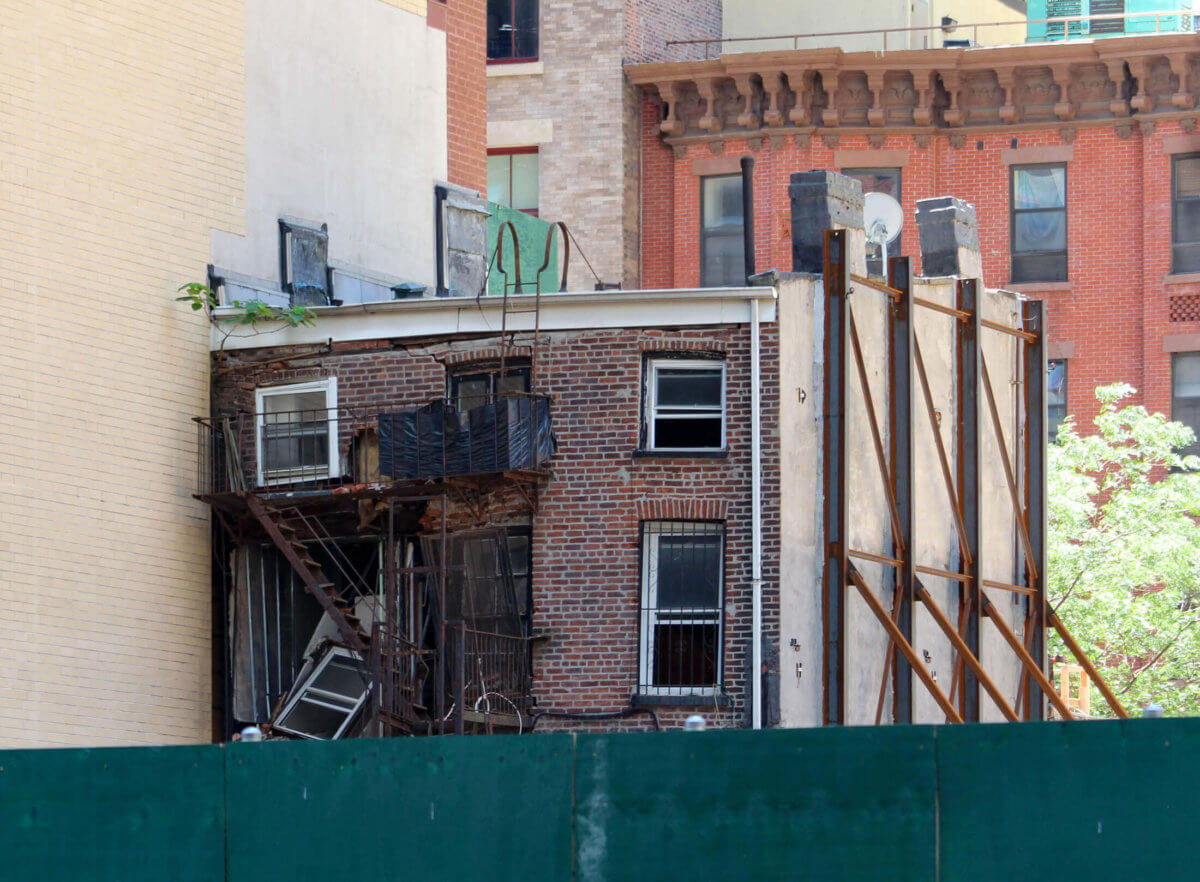Back Stage at Playbill
Around a week or so ago, Kevin Walsh spotlighted the Playbill Manufacturing Plant in this Q’Stoner post from May 23rd. Today, we get to see what’s happening behind the walls. The Woodside institution has been in the neighborhood since the 1960s, and recently I was invited inside the plant. Here’s what I found when I…

Around a week or so ago, Kevin Walsh spotlighted the Playbill Manufacturing Plant in this Q’Stoner post from May 23rd. Today, we get to see what’s happening behind the walls.
The Woodside institution has been in the neighborhood since the 1960s, and recently I was invited inside the plant. Here’s what I found when I was recently invited back stage at Playbill.
Pictured above is Claire Mangan, Playbill’s Managing Program Editor.
When you enter the place, the first thing you smell is ink. The first thing you hear is the “chugga chugga chugga” sound of high speed printing presses. Print shops are busy places, with hundreds or thousands of moving parts. Playbill has an assortment of equipment employed here, but this isn’t where the process starts, rather its where it ends.
From Wikipedia:
Playbill was first printed in 1884 for a single theatre on 21st Street in New York City. The magazine is now used at nearly every Broadway theatre, as well as many Off-Broadway productions. Outside New York City, Playbill is used at theatres throughout the United States, including in Birmingham, Alabama; Boston; Chicago; Cincinnati; Columbus, Ohio; Dallas; East Lansing, Michigan; Houston; Indianapolis; Los Angeles; Miami; Minneapolis; Philadelphia; Phoenix; Pittsburgh; St. Louis; San Diego; San Francisco; and Washington, D.C.. Circulation as of September 2012 was 4,073,680.
Playbill’s writers and editors, working with graphic artists, digitally compose the magazines.
Approved files are then printed in house, as plastic printing plates.
From pneac.org:
Prepress operations encompass that series of steps during which the idea for a printed image is converted into an image carrier such as a plate, cylinder, or screen. Prepress operations include composition and typesetting, graphic arts photography, image assembly, and image carrier preparation. Press refers to actual printing operations. Postpress primarily involves the assembly of printed materials and consists of binding and finishing operations.
Robert Cusanelli is the Director of Manufacturing at Playbill’s Woodside plant, and here he’s reviewing the printing plates before moving them along to the production floor.
Playbill is involved with more than just NYC’s theater world- out of the Woodside plant alone, they manufacture magazine brochures for Broadway, Off-Broadway, Lincoln Center, The Met, NYC Ballet, Carnegie Hall, The Kennedy Center, and the Philadelphia Orchestra. Other national venues are produced in house and printed regionally.
Playbill produces upwards of 600,000 magazines a week here, as Mr. Cusanelli proudly stated.
From Wikipedia:
Frank Vance Strauss was an Ohio business man who was the first to specialize in printing the theatre programme in New York City. He began by collecting ads for the Madison Square Theatre and transformed the programme from a four page leaflet into a magazine playbill that included advertisements along with the credits. Strauss began his work in 1884, and a year later recruited companies like Caswell Massey, Runkel Brothers Cocoa, and Schirmer Pianos to be advertised in his programs. In 1891, Strauss merged with his main competitor and, by 1905, standardized the “design and layout of the programs so that the makeup would be easier and the sizes of advertising space uniform. Because the programs were made of such a higher quality, audiences were collecting them as souvenirs. Strauss, along with other publishers, started to create albums and leather-bound volumes specifically for collecting programs. In 1918, Strauss sold the company to his nephew, Richard M. Huber.
Under Huber the company’s name changed to The Magazine Theater Program and, by 1924, was printing 16,000,000 playbills for over 60 theatres.
45 to 50 people work at the plant at any given time, many of whom are local to Queens. One senses a real family atmosphere around Playbill.
Mr. Cusanelli volunteered that his father had worked at this self same plant for some 44 years, and that his two brothers work here as well .
Playbill is a family owned company, one which is headed by Phillip S. Birsh, who operates the company out of its Manhattan offices.
From playbill.com:
Strauss’ nephew, Richard M. Huber, sold the company to Broadway producer Roger L. Stevens in 1956. Stevens experimented briefly with a single cover for every Playbill, an innovation that brought howls from collectors. He soon returned to the colored logo and rebranded the magazine from The Playbill to simply Playbill. Gilman Kraft bought the company in 1960 and sold it to conglomerate Metromedia in 1968, but not before hiring as publisher Arthur T. Birsh, a master printer who invented the process that allowed Playbill to print color ads.
The Broadway box office took a nosedive in the early 1970s, and the short-lived innovation of a lemon-orange-raspberry logo didn’t seem to help. Metromedia was happy to sell the company to Birsh in 1974 — just in time for the Broadway renaissance that unfurled with the opening of A Chorus Line in 1975. Playbill has remained in the hands of the Birsh family ever since.
The printing process is highly automated, as you’d expect from the sort of volume that the plant produces.
There are machines that print, fold, staple, collate – you name it. At every stop along the way, an operator is overseeing the process and ensuring quality controls.
From Wikipedia:
A folding machine is a machine used primarily for the folding of paper. Paper can be folded with either a buckle or a knife; thus, there are generally three types of folding machines: buckle folders, knife folders or a combination of these two types. Whilst buckle folding is the more popular of the two methods, knife folding is sometimes preferable. Folding machine models vary in sophistication, with high-end machines capable of processing more complex folding jobs and unusual paper forms (in terms of density and size).
The interior of Playbill is BW, or “one color” as printers would describe it. The covers are four color process, which allows for color reproduction.
From Wikipedia:
Color printing or colour printing is the reproduction of an image or text in color (as opposed to simpler black and white or monochrome printing). Any natural scene or color photograph can be optically and physiologically dissected into three primary colors, red, green and blue, roughly equal amounts of which give rise to the perception of white, and different proportions of which give rise to the visual sensations of all other colors. The additive combination of any two primary colors in roughly equal proportion gives rise to the perception of a secondary color. For example, red and green yields yellow, red and blue yields magenta (a purple hue), and green and blue yield cyan (a turquoise hue). Only yellow is counter-intuitive. Yellow, cyan and magenta are merely the “basic” secondary colors: unequal mixtures of the primaries give rise to perception of many other colors all of which may be considered “tertiary.”
Printer sheets carry multiple impressions of the cover, called a “Step-and-repeat,” and require cutting before they can be married to the interiors.
That’s accomplished on another one of the industrial machines, a cutter which can accurately divide the sheet into specified sizes. Once finished, binding can begin.
The cover and interior are joined, and fed through yet another mechanism which folds and fastens. At the end of this process, another series of cuts are applied, which trims the magazine to final size.
The trimmed magazines travel to the bundling machine next, which sort and counts them. The operator activates a process which ties them off with twine once the proper count is achieved.
The finished bundles are stacked on palettes.
Then they are packaged with addressees indicated on the box.
And they are finally loaded onto Playbill’s trucks.
When the trucks are loaded and on the way to Playbill’s customers, the show can finally get started.
A fantastic little piece at NYTimes.com explores the dilemma Playbill encountered in supplying their Broadway clientele after a record blizzard, back in 2010 — check it out here.
Newtown Creek Alliance Historian Mitch Waxman lives in Astoria and blogs at Newtown Pentacle.




























What's Your Take? Leave a Comment